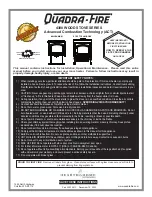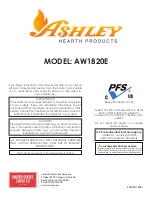
BOX 422 • TOWER, MN 55790 • USA • Tel (218) 753-2330 • www.lamppakuuma.com
19
CAUTION
ELECTRIC POWER FAILURE
– TO IMPROVE GRAVITY AIR FLOW REMOVE
AIR FILTERS.
– DO NOT TAMPER WITH WOOD PRIMARY
AIR CONTROL.
– OPEN ALL AIR REGISTERS AND REMOVE
ALL OBSTRUCTIONS NEAR THEM.
– KEEP CHILDREN AWAY FROM AIR
REGISTERS, OR BURNS COULD RESULT.
– PRIMARY AIR DAMPER WILL OPERATE
AUTOMATICALLY WHEN ELECTRIC
POWER IS RESTORED.
– REMOVE FRONT LIFT OFF HOOD FOR
MORE GRAVITY HEAT FLOW.
NOTE
IF FOR ANY REASON THERE SHOULD BE
AN ELECTRIC POWER FAILURE, EITHER
FROM HIGH LIMIT CUT-OFF OR ELECTRICAL
POWER OUTAGE, THE DAMPER WILL
AUTOMATICALLY CLOSE, PREVENTING
OVER-FIRE WITH NO BLOWER AND HEAT
EXCHANGER DAMAGE.
RUNNING FURNACE DURING
POWER FAILURE
If unit was in operation
during a power failure,
leave ash and fire doors
closed.
WOOD BURNING FACTS
BE AWARE OF CREOSOTE “BUILD-UP” WHEN
BURNING WOOD!
Wood burning equipment will give you trouble with
creosote deposits under certain conditions, unless
you are aware of these conditions and avoid them.
Creosote is a tarry liquid or solid resulting from the
distilling of wood during the combustion process. It
consists of a number of elements which condense
and bake layer upon layer in the chimney flue.
Highly combustible in its solid and semi-liquid state,
creosote is present in the gases given off by burning
wood. Creosote may build up a considerable thick-
ness on the interior surface of the chimney and flue
pipes, considerably reducing their cross-sectional
area.
Creosote condenses from the flue gases when the
stack temperature drops below 250 degrees F. The
amount of creosote deposited in the pipe and chim-
ney is dependent on the amount of moisture in the
flue gases, the temperature of the stack, and how
completely the combustible elements in the flue
gases have been burned in the combustion pro-
cess. Most problems with creosote are due to poor
chimneys with low draft and cold walls and to a
low rate of burning when heat is needed during the
spring and fall months.
Moisture in the flue gases may be controlled by us-
ing the driest wood possible, mixing small pieces
with a very full load, and never using only large
wood during mild weather when combustion is rela-
tively slow. Use seasoned firewood approximately
15% to 30% moisture content.
WARNING
SERIOUS FIRE MAY RESULT IF A SUFFICIENT
CREOSOTE “BUILD-UP” IS PERMITTED OVER
AN EXTENDED PERIOD OF TIME.









































